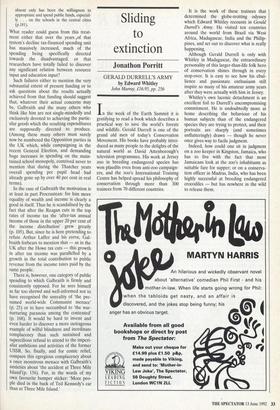Sliding to extinction
Jonathon Porritt
GERALD DURRELL'S ARMY by Edward Whitley
John Murray, f16.95, pp. 256
In the week of the Earth Summit it is gratifying to read a book which describes a practical way to save the world's forests and wildlife. Gerald Durrell is one of the grand old men of today's Conservation Movement. His books have probably intro- duced as many people to the delights of the natural world as David Attenborough's television programmes. His work at Jersey zoo in breeding endangered species has won plaudits even from anti-zoo campaign- ers, and the zoo's International Training Centre has helped spread his philosophy of conservation through more than 300 trainees from 70 different countries. It is the work of these trainees that determined the globe-trotting odyssey which Edward Whitley recounts in Gerald Durrell's Army. He visited• ten countries around the world from Brazil via West Africa, Madagascar, India and the Philip- pines, and set out to discover what is really happening.
Although Gerald Durrell is only with Whitley in Madagascar, the extraordinary personality of this larger-than-life folk hero of conservation shines through in every stop-over. It is easy to see how his ebul- lience and passionate enthusiasm still inspire so many of his amateur army years after they were actually with him in Jersey.
Whitley's own laconic detachment is an excellent foil to Durrell's uncompromising commitment. He is undoubtedly more at home describing the behaviour of his human subjects than of the endangered species they are trying to protect, and their portraits are sharply (and sometimes unflatteringly) drawn — though he never once gives way to facile judgment.
Indeed, how could one sit in judgment on a zoo keeper in Kingston, Jamaica, who has to live with the fact that most Jamaicans look at the zoo's inhabitants as suitable fare for supper; or on a conserva- tion officer in Madras, India, who has been highly successful at breeding endangered crocodiles — but has nowhere in the wild to release them. The footsoldiers in Gerald Durrell's Army have experienced their fair share of both triumph and defeat. Indeed the dominant mood of the book is tragicomedy. Whitley's anecdotal and bouncy style makes the most of the many absurd and even surreal situa- tions that he ends up in, but there is a steady throb of anger and despair as he contemplates the folly of humankind and the speed with which so many of the species he sees are heading inevitably for extinction — despite the support of Jersey zoo.
The three sub-species of tamarin, for instance, are now confined to three sepa- rate reserves on the east coast of Brazil (all that is left of that country's low-lying coastal forest, 98 per cent of which has been cut down since the turn of the centu- ry). Because there are so few of them (between 300 and 500 of each) and because their already shrunken habitats are being further fragmented by new roads and new settlements, genetic inbreeding all but guarantees their extinction before 2025.
In one way or another, all the species in this book are threatened by the same phe- nomenon: the inexorable expansion of human numbers, pressing harder and hard- er on even the most marginal of habitats to produce ever larger amounts of food. The need to relieve hunger and poverty inevitably weighs more heavily on local politicians than the need to protect endan- gered species — about which there is often little awareness, much less concern.
For the author — and even more for Gerald Durrell — this oft-repeated pattern of the slippery slope to extinction is like watching a loved one die slowly of an incur- able disease. In the Philippines there are just 23 nest sites of the Monkey-eating Eagle left. Each pair needs around 60 square kilometres of virgin rainforest to support it, and the Philippines have axed their forests so quickly (from five million hectares in 1970 to just 600,000 hectares in 1991) that there are mighty few patches of 60 square kilometres left.
Two images from the Philippines will always remain with me, and in many ways sum up the alternating moods of this wide- ranging book. The first is the macabre sight of an assistant at the Philippine Eagle Con- servation Programme who puts on a heavy hooded leather jacket and goes into the cage of the Monkey-Eating Eagle, which has a wing span of eight feet. His job is to allow this vast eagle to mate with his head while he has to gather up the sperm in his hand to be injected into a female eagle.
The second is when Whitley goes into the forest and finds an eagle chick on one of the 23 remaining wild nesting sites. As
he watches it, the silence is shattered by a chainsaw. The chick will only realise that there is no forest to live in when it leaves the nest. In a poignant ending to the book, Whitley explains that in six years' time there will be no forest left in the Philip- pines — and no Monkey-Eating Eagles.



















































 Previous page
Previous page